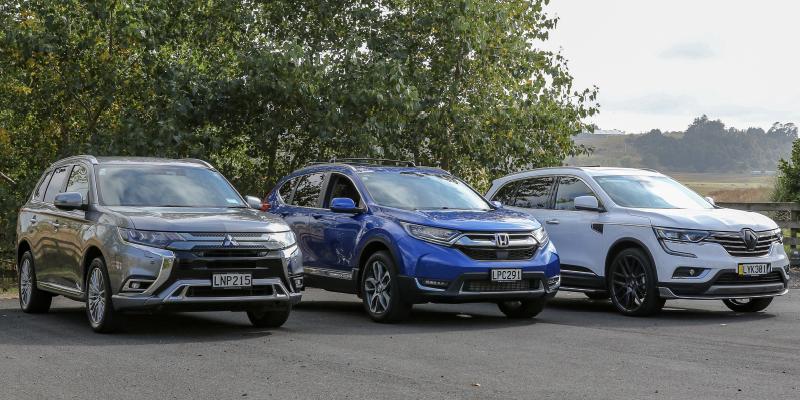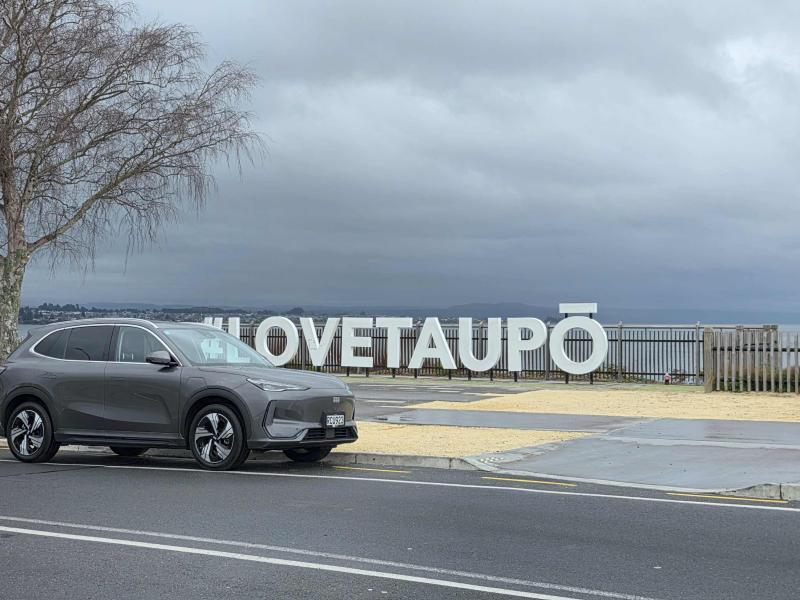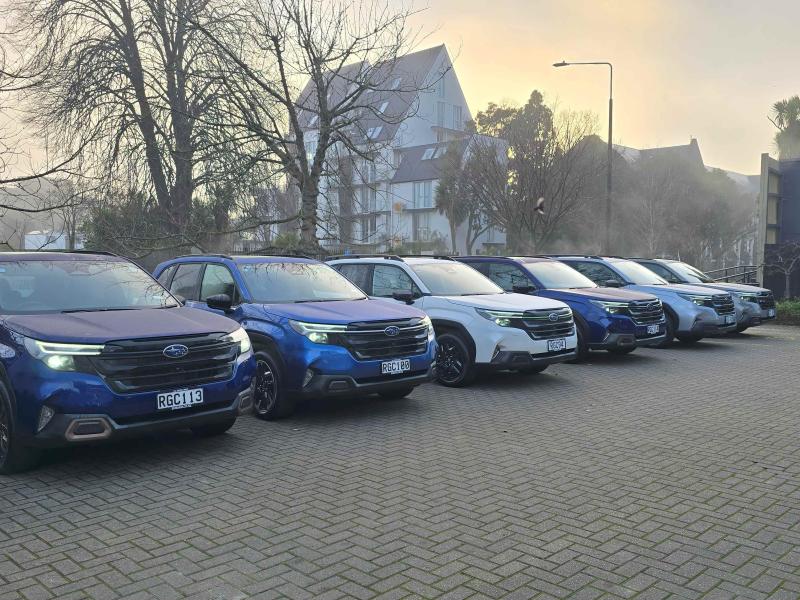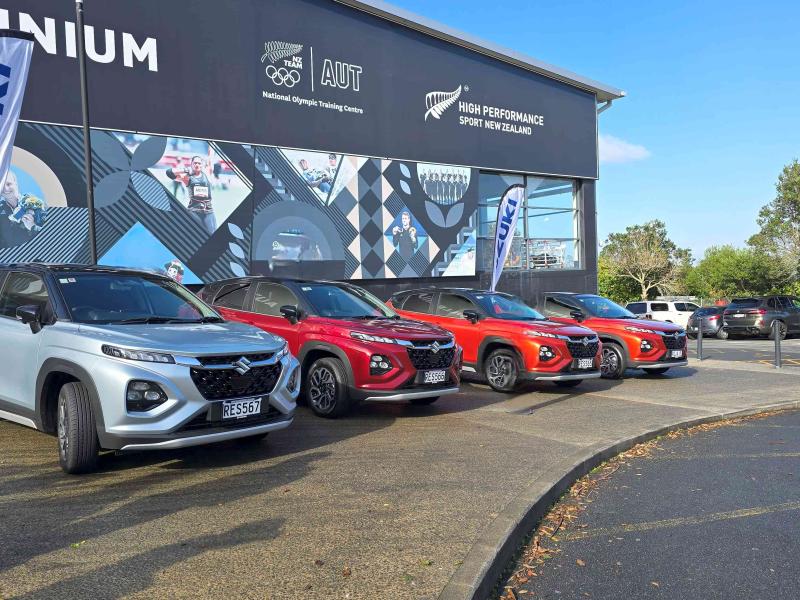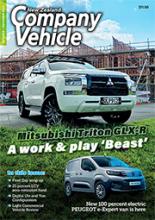We are looking at the medium SUV segment – arguably the most fiercely contested segment in the automotive market so getting hold of some media demonstrators should be a doddle, right? Wrong!
With vehicles having to come from Wellington, diesel engine versions not being available and oh yes, the near-on punch up to get the keys to the favourite...
All right, enough griping. Let’s start at the beginning: we managed to scare up our vehicular contenders, and I called up our emergency third ‘volunteer’ (cheers, Mr Baker!) so we had our three crash test dummies and our invoice-approved version of Steven Spielberg to take our pretty pictures (welcome back, Graham Hughes). Now, what were we going to do with all of this?
Well, mid-sized SUVs don’t really have a natural hunting ground, they are kind of like the Adelie Penguins of the automotive industry, clocking up 17,600kms in a year chasing the sun from place to place mostly for food and er, nookie. I guess those who own medium SUVs do the same thing.
Medium SUVs see close to 2000 registrations each month, the 30 models classed as medium (everything from a Mazda CX-5 to a Jaguar F-Pace) comfortably outsell large ones (think Audi Q7 or Toyota Land Cruiser Prado) by at least 750 units a month.
The only serious competition, in fact, comes from the small SUV sector (Toyota CH-R, Nissan Qashqai etc) with monthly registrations around the 1700 mark.
Needs must, as they say, and medium-size SUVs like the trio here (Honda’s CR-V, Mitsubishi’s Outlander PHEV, and Renault Koleos) cover pretty much all the key family first or second ‘car’ basics.
To this end, you’ll find medium SUVs all over the place: suburbia, cruising the open highways, on tarmac, in the sand, in campgrounds, company carparks and pretty much everywhere else really.
This gave our route planners a bit of a headache: where do we go that so well encapsulates the versatility of these vehicles?
It was a problem that we never really found an answer for, so with complete (misplaced) confidence in my ability to find the perfect test area, the team rendezvoused at Hampton Downs raceway to start our test day.
Due to the vagaries of pick-up locations, the pecking order was: Sean in the Mitsubishi Outlander PHEV, “Crash” Mackay in the Honda CR-V Active Sensing and the fabulous Baker Boy in the Renault Koleos Sport.
Oh, and the camera guy? Yeah, we attached him to Mackay for most of the day. It seemed like the right thing to do.
The safety briefing was done expeditiously (Don’t bend ‘em or you’ve bought ‘em) and we handed over the reins to the man with the lens who calls Te Kauwhata home, so I figured he’d have a good handle on where best to photograph a selection of medium SUVs.
We started with a quick look at the back end of Hampton Downs and right away, the hybrid power of the Mitsubishi proved its mettle, the twin electrics delivering an instant acceleration response and the petrol picking it all up to maintain a healthy lead.
The Honda tried to keep up, but even with the turbocharged 1.5 VTEC, it was no match for the Mitsi’s instant throttle response. The general consensus was the Honda had much better handling though.
Tail end Charlie duties – for most of the day, in fact – fell to the Koleos, which in fact, wasn’t such a bad thing. Being the largest and most formidable, it provided a very good rear guard. It also presented whoever was in front of it with a sense of urgency to try and get away from that overbearing front grille!
The line astern formation was the order of the day, with the Mitsi predominantly leading the pack, regardless of who was driving. As far as having a sprightly SUV goes, it was hard, if not impossible to pass the Triple Diamond machine, unless it was pulled over and stationary. The beauty of the hybrid of course, was the faster you went, the more energy you could expend when slowing down, and thereby the more charge you could shunt back into the battery.
As a result, for all that the Mitsi was a powerhouse in take-off, it was by far and away the most miserly on fuel and high-speed take-offs are not usually described as being conducive to efficient fuel consumption.
The Honda meantime, enjoyed a relaxed day as the meat in the sandwich, not really impressing with its urgency, but providing arguably the most comfortable ride that completely failed to tax the driver. There was a sense that SUV and driver could travel on all day and all night and lack for nothing in terms of vehicle dynamics, performance, equipment and specification.
The Renault seemed to be in its element at the back end of the group. Here, those who wanted to, could drop back until the tail lights of the Honda were on the horizon, then bound forward, unleashing the full might of the largest displacement engine within the trio, gobbling up the road on its massive 22-inch feet which felt suspiciously as though they were only just constrained by the white lines on either side of the French flagship.
Unlike three-way comparisons in the past, where the opinions were wide and varied, making it challenging to determine an outright ‘’top choice’’, this time around folks, we had an almost perfect Gold, Silver, Bronze result.
There was actually no dissension in the ranks as to who was the leader of the pack, with Honda taking a well-deserved raft of praise from all testers.
No, it was a scrap between the Renault and the Mitsubishi, which isn’t really much of a scrap considering these two brands are (French?) kissing cousins anyway (globally, Renault and Mitsubishi are part of the Renault-Nissan Alliance, and little birdies are suggesting there is going to be a closer link between Renault and Mitsubishi (particularly in light commercials) as far as our market is concerned.
We’ve already told you who won, so what was the outcome of our little stoush when it came to the next in line?
Well, if it had come to blows, Mackay’s boxing prowess might have had a weightier impact than Baker’s extra-curricular activities, which include mountain biking, so not much contest there. Sean on the other hand, outweighs Ross by a good metric tonne, so its questionable as to who would win that one.
It was, however, a two-sided contest, Mackay and Baker favouring the Mitsi for second spot, Sean opting for the Renault.
As the primary author of this article, much though it pains me to say it, the second podium went to Mitsubishi, with the Renault coming third (very closely though, I’m going to say).
In the final analysis and after a debrief back at Hampton Downs, the best summation of who won and why is contained within Ross’s reports on all three vehicles, so here are his thoughts, which crystallise those of Mark and myself (mostly).
Honda CR-V AWD Sport Sensing
Like Subaru, Honda has eked out a special place in the hearts of Kiwi car buyers, thanks to iconic models like the Civic and CR-V.
And, after our day-long drive through the north Waikato hinterland, it was the CRV AWD Sport Sensing (to give it its full name) that was the standout for me.
In no particular order, I liked the light, airy ‘feel’ of the interior despite its dark charcoal (as close to black as it is possible to get) leather seat and dash/seat card trim.
I also liked the way the ‘gear’ lever and electronic hand brake ’switch’ are mounted high on the central console, effectively freeing up room directly below for your phone, and the space in between the seats for a storage compartment.
I liked the way the instrument cluster combines a large digital readout of your speed with the engine revs showing on a curved readout behind. And I think the way Honda uses the reversing camera screen to show you what’s on your left when you indicate to turn is genius.
I loved the instant response and impressive, real-world way the hi-tech (turbocharged and VETEC-equipped) little 1.5 litre engine went about its work, always enthusiastically but never using more than the odd sip of petrol.
Though I am no fan of any CVT transmission, I reluctantly agreed with my two fellow testers that the one Honda uses on the CR-V (which you can use with or without the flappy paddles mounted behind the steering wheel) is, if not as intuitive as a Subaru one, at least not as downright cranky as the ones I have used in various small Mazdas over the years.
I also liked the distinctive ‘sculpted’ form of the latest CR-V. It’s not for everyone,
but gives the Honda a distinctive ‘soft edginess’ (If there is such a thing) which imparts a sense of solidity without adding any extra bulk or weight to the already substantial looking (though not feeling) doors.
Dynamically there’s also a feeling of substance about the CR-V, though – again- not at the expense of road manners, in the city or out on the open road.
Ride is plush and well-damped in a long wheelbase/long-travel way which reminded me of standout Peugeots and Renaults of old. (That’s a good thing in case you are wondering.) Yet with the latest electric power steering package, there’s no price to pay for all that big car stability and ride when you are trying to manoeuvre into a tight parking spot in town.
Finally, the lane departure ‘advisory system’ fitted to the CR-V is one of the better ones, offering gentle guidance back within the lane markers, rather than the roughhouse ‘grab, slap and forcibly take control’ of some of the first-gen systems to hit the market here.
Mitsubishi Outlander PHEV
I had a bit of explaining to do round the office when I turned up one day – coming up to two years ago – with a Jap import Outlander I bought to replace the ‘family’ Subaru 250T station wagon.
“Isn’t that the car you said had steering as light (and therefore as predictable) as wind-blown straw, not to mention a CVT transmission which seemed to work off a different script to the (harsh, thrashy) engine?” one of my co-workers asked.
It was. Yet when I went looking, with my own (pathetically small) amount of ‘real, cash money,’ I simply could not resist the very real ’bang-for-my-buck’ the 10-year-old five-seat 137,000km ‘Outie’ represented.
Two years on, it still starts first thing every morning, sips petrol modestly and bar the overly-assisted power steering still being a bone of contention, I’m as happy now as I was when I first bought it.
Which is pretty much how I think I would be feeling right now had I been one of the earliest of early adopters and bought one of Mitsubishi’s innovative PHEV (Plug-In Hybrid Electric Vehicle) Outlanders.
OK, with an electric only range of just 54kms before you have to recharge its batteries, a Tesla S or X model it is not!
What I particularly like about the PHEV version of Mitsubishi Outlander, however – and what my latest time behind the wheel confirmed – is its very ordinaryness. Bar playing around with the regenerative braking mode so you do not constantly drain the battery, you could, for instance be behind the wheel of a conventional Outlander.
Which is no bad thing, and – in my humble opinion – is the key to the appeal of the PHEV model.
Like its more conventional cousins, for instance, it is a roomy, comfortable, well-specced modern Medium size SUV with what Del-Boy from the classic cockney trader TV series Only Fools and Horses would describe as having “all the bells and whistles.”
Dig beneath the surface though and you have one of the most innovative yet day-to-day practical EV systems yet devised.
For a start, there is still a conventional two-litre petrol engine under the bonnet, meaning no EV range anxiety. Even if you run out of battery charge, it will still get you home!
Rather than transfer its 88kW of peak power and 189Nm of peak torque to the front and/or rear wheels though, the engine drives a generator which in turn, feeds a battery bank set low under the passenger compartment.
It is from this battery array that two separate electric motors (one which drives the front two wheels, the other the rear pair) draw their ‘juice.’
Effectively then you have an electric drivetrain which drives the front and rear wheels full-time and which can be locked electronically if you want the sort of full-time 4WD for travelling off-road a locking central diff might offer on a conventional AWD vehicle.
There is also a clutch pack which can lock in drive to the front wheels if you choose to run in what’s called ‘Parallel Hybrid Mode.’ By simply flicking a switch, however, the rear motor can constantly recharge the system, meaning that you can effectively run in ‘EV mode’ most of the time.
If anything, all this tech makes the PHEV more involving (again, I see this as a good thing) to drive than its conventional cousins. Steering feel is certainly way less wishy-washy than in my 12-year-old model. And handling is – again, if anything – more neutral (less understeery) with drive going to all four wheels rather than just the front pair all the time.
So I liked it? I certainly did. In this company I’d still rate the CR-V higher on my ‘perfect world’ scale. But if you are committed to ‘going electric’ when it is time to replace your current (sorry!) SUV, I’m thinking that the Mitsubishi Outlander PHEV is your only real-world practical option!
Renault Koleos
Meanwhile, in the ‘woo-hoo, that’s flash’ corner comes the new and certainly visually stunning Renault Koleos Intens Sport Petrol 4WD, an extrovert’s ‘car’ if ever I saw one.
With 22-inch. alloy wheels and big fat 265/35Z tyres making up part of the standard spec you are never going to be able to slip quietly into the background in this particular Koleos, which should in theory suit a car-mad bloke like me down to the ground.
As it turned out, of the three Medium SUVs in this sample, it was the one I struggled to bond with.
Like the Nissan X-Trail on which it is based, the Koleos is powered by the largest engine of our test trio (a non-turbo 2.5 litre four-cylinder petrol) yet in this company it lacked the instant urge of the Honda’s 1.5 litre turbo or the torque-drenched mid-range of the turbine-smooth (because it is!) of the Outlander PHEV.
Not helping is the CVT transmission which is seamless (good) but gives the impression that it’s in no hurry (even if you are!) to help the engine turn its work rate into forward motion.
In its defence, the ride round town or out on the open road wasn’t as harsh and ‘jiggly’ as I was expecting with the 22-inch rims and 35 profile tyres. I also liked the driving position and general roomy-ness of the cabin.
That said, I struggled to find a quick, easy and intuitive way to modulate the air flow (on a particularly hot day), eventually have to pull over and head to the Tesla-style portrait-mounted touch screen.
Once there it was a simple matter of holding your finger over a bar diagram. But soon after I was quickly back into the air con menu’ because on ‘full send’ the noise the fan made was so distracting I had to ‘turn it down!’
To make matters worse, while scrolling through the various functions on the steering wheel, I somehow managed to hook up a speed limiting function, meaning a 40km/h maximum on (fortunately) a bit of back road skirting Maramarua Forest.
By the time I had twigged what had happened, and stopped to re-adjust the settings, my colleagues were long gone. And when I finally caught up with them, I was even more hot and bothered with the air con fan on half so that I could at least hear the radio, despite my never quite managing to find my favourite station – or adjust the volume of the pre-set one without re-activating the speed limiting function...
So it seems at least one of our testers is somewhat challenged by Renault’s idea of modern technology. To be fair, we all had some fun and games with the ‘Big Frog’, but then a few hours more with ‘Le Manual Flight’ and we might not have had that problem.
Of course, when doing multiple comparisons, there are multiple things to take into consideration.
Sean and Mark, having younger families, were looking at other aspects, notably cargo space and ease of loading, while Sean seems to have the best handle on moving masses of people on a regular basis.
While fleet users will be looking more at the versatility factor for the M to F, 9 to 5, the SUV’s role as a ‘’roadie at the weekend’’ vehicle has to be factored in.
In these respects, the winners were slightly different, but not by much. The Honda had the biggest mouth which made it the easiest to load and it also had surprisingly the biggest rear capacity with seats up and down at 522 litres and an astonishing 1084 litres respectively.
The next one was rather odd: the Mitsi took line honours for seats up space at 463 litres as opposed the Renault’s 458, but if you folded the seats, the story ran differently, with the Mitsi providing 886 litres to the Renault’s 942.
As to seatable space, the Koleos won here. The Mitsi can cope with three larger teens in the back, but you will be stopping to change positions to ensure the centremost occupant doesn’t lose all feeling in their legs.
The Honda copes well enough, but given the sophistication of the vehicle, taking four people is the best bet to experience the level of luxury Honda has built into the SUV.
The Koleos on the other hand, gives space a plenty and we imagine the apparent coarseness of the ride on those big feet is mitigated considerably when the Renault is running fully laden.
So there you go, three very different answers to the same question with the order of preference matching the alphabet:
Style and substance – Renault Koleos
The Renault Koleos cuts an imposing figure. Renault’s sports styling for the Koleos takes it a step further from some of the generic ‘family’ look rivals not part of the test.
Add in sporting touches like a comprehensive body kit, side steps, blacked-out grille insignia and very distinctive LED running lights set into a sculpted front end.
Koleos has the most commanding driving position of the three on test. The driver sits high and views the road across a fairly flat expanse of bonnet that curls up slightly at each edge, giving a good sense of where to place the front wheels on those flowing rural B roads leading to your favourite beach.
The Koleos is certainly the grip leader of the trio, though it might be worth looking for slightly narrower wheels and tyres if you do a lot of dirt road km though, pea gravel can make the big SUV’s interaction with the road slightly skaty.
Alll three of our contenders here are within a similar power range. More important around town and in ‘shiny’ off-road excursions is the torque figure. In this, Koleos splits the pack with 226 Nm, though its peak develops at a high-ish 4400 rpm.
The engine is a 2.5-litre four cylinder which never actually sounds like it is endowed with pots that big but, coupled to the CVT transmission, produces a seamless forward surge from any speed. The transmission has a semi-sequential function activated by pushing the lever to the left.
Though the transmission lacks a right-hand drive surround – meaning the gear you select isn’t immediately visible when driving – the gear selected is also represented on the dash – which is where all such information should be.
I particularly like its pictogram showing torque apportioning by the very clever transmission – on tarmac we’re usually 95 percent front, going to 100 percent on deceleration but pulling effort more to the rear to give more ‘bite’ in low-grip situations and while you may not feel it, you can see it.
Through the R-line media and nav portal we have all the expected and very useful electronic assists: Bluetooth, Bose sound system, navigation with traffic notifications, while the big centre-mounted screen gives access to page after page of menu options including the ability to raise or lower the sound of the indicators – up for the hard of hearing and down for those who actually use their indicators around town.
The Renault is rated for a realistic 2000 kg (braked) and 750 kg unbraked.
User friendly technology - Mitsubishi Outlander
As Company Vehicle has noted before, Mitsubishi’s Outlander PHEV system isn’t designed to have motorists cruising for hundreds of km in eerie electric silence.
Rather, it’s augmenting the vehicle’s main drive system, and the coolest thing about that is that it has a very efficient regenerative function – deceleration and braking see the SUV pouring power back into its battery. There’s also a ‘save’ mode which preserves charge in the battery, and further a ‘charge’ mode so the engine directly charges the battery.
The Outlander gave a seat of the pants feel that it was just slightly reluctant to go when asked. Its torque figure is 189 Nm at 4,500 rpm, which contributes to this. But then how to account for its ability to run with the pack, and how to factor in the additional 137 front/195 rear Nm provided by the electric motors?
Purely subjectively, the Renault would run ahead over the old-fashioned quarter mile, though the PHEV would of course leap out of the start much more quickly.
It’s certainly possible to stir the CVT transmission along but it seems somehow rude to do so when – given the size of the vehicle – the CVT does a pretty good job.
Braking is on par with the others on test, which means the driver is reminded of the mass they are directing along the road but never in a way that causes a furrowed brow when asked to stop quickly.
The ‘office’ in the Outlander is well laid out and chock full of the information the driver is likely to need from minute to minute. The screen is touch-enabled – more intuitive than having to find an arrow button or key or use an MMI knob to burrow through layers of information. Downside? Those with a need to tidy will find themselves keeping a cloth in the car to wipe off finger smears.
Towing is not what the Outlander was built for and maximum loads are 750 kg whether braked or not.
Handling master - Honda CR-V
Last century, Honda made waves with the CR-V in its first iteration, with huge thought put into how to use every cm of available space to greatest effect. There was even a picnic table cleverly hidden in a floor cubby.
Fast forward into the new century and we find the latest version of Honda’s very advanced engine technology – a 1.5-litre turbo VTEC four-cylinder engine coupled to a seven speed CVT transmission. The dynamic drive dream comes true, and as always in a package chock-full of cleverness.
These small, light pressure, ‘instant –on’ turbo applications are becoming the Next Big Thing out of Japan. They offer response, efficiency, long life and user-friendly torque low-down where it’s needed. That’s 240 Nm between 2,000 and 5,000 rpm. More a torque plateau than a torque curve.
This is the most neutral-handling of the three and that endows the driver with confidence when driving on unfamiliar roads or in bad weather.
Honda also fits a left-hand camera that comes on when cornering left so you can see where that pesky front wheel is going. Activated when the driver indicates left, LaneWatch increases sideways visibility up to 50m.
The camera is mounted on the passenger side mirror and displays the view on the screen in the centre console, increasing the standard 22° view from the side mirror to a sweeping 80° with distance indicators. This mean the driver can change lanes more safely and when turning left, ensures the kerb is visible.
The tech also proves handy in tight ‘soft-roader’ going. More confidence when the driveway to the bach has been hammered by those summer storms or you need to edge past a dropped tree or washout. It does happen you know!
In summary, the CR-V is where driving dynamics meets with some enormous tech advances and the clever design for which Honda has always been famous.
The CRV will ‘only’ tow 1500 kg (braked) – so leave one of those jet skis home.


